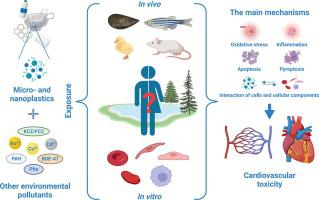Environment International ( IF 11.8 ) Pub Date : 2022-11-26 , DOI: 10.1016/j.envint.2022.107662 Xiaoqi Zhu 1 , Chuanxuan Wang 1 , Xiaoyu Duan 2 , Boxuan Liang 1 , Elvis Genbo Xu 2 , Zhenlie Huang 1

|
Exposure to micro- and nanoplastics (MNPs) is inevitable due to their omnipresence in the environment. A growing body of studies has advanced our understanding of the potential toxicity of MNPs but knowledge gaps still exist regarding the adverse effects of MNPs on the cardiovascular system and underlying mechanisms, particularly in humans. Here, we reviewed up-to-date data published in the past 10 years on MNP-driven cardiovascular toxicity and mechanisms. Forty-six articles concerning ADME (absorption, distribution, and aggregation behaviors) and toxicity of MNPs in the circulatory system of animals and human cells were analyzed and summarized. The results showed that MNPs affected cardiac functions and caused toxicity on (micro)vascular sites. Direct cardiac toxicity of MNPs included abnormal heart rate, cardiac function impairment, pericardial edema, and myocardial fibrosis. On (micro)vascular sites, MNPs induced hemolysis, thrombosis, blood coagulation, and vascular endothelial damage. The main mechanisms included oxidative stress, inflammation, apoptosis, pyroptosis, and interaction between MNPs and multiple cellular components. Cardiovascular toxicity was determined by the properties (type, size, surface, and structure) of MNPs, exposure dose and duration, protein presence, the life stage, sex, and species of the tested organisms, as well as the interaction with other environmental contamination. The limited quantitative information on MNPs’ ADME and the lack of guidelines for MNP cardiotoxicity testing makes risk assessment on cardiac health impossible. Furthermore, the future directions of cardiovascular research on MNPs are recommended to enable more realistic health risk assessment.
中文翻译:

微塑料和纳米塑料:一种新的心血管危险因素?
由于微塑料和纳米塑料 (MNP) 在环境中无处不在,因此接触它们是不可避免的。越来越多的研究提高了我们对 MNPs 潜在毒性的理解,但关于 MNPs 对心血管系统和潜在机制的不利影响,尤其是对人类,仍然存在知识空白。在这里,我们回顾了过去 10 年发表的关于 MNP 驱动的心血管毒性和机制的最新数据。分析总结了46篇关于MNPs在动物和人体细胞循环系统中的ADME(吸收、分布和聚集行为)和毒性的文章。结果表明,MNPs 影响心脏功能并对(微)血管部位造成毒性。MNPs的直接心脏毒性包括心率异常、心功能损害、心包水肿和心肌纤维化。在(微)血管部位,MNPs 诱导溶血、血栓形成、血液凝固和血管内皮损伤。主要机制包括氧化应激、炎症、细胞凋亡、细胞焦亡以及 MNP 与多种细胞成分之间的相互作用。心血管毒性取决于 MNP 的特性(类型、大小、表面和结构)、暴露剂量和持续时间、蛋白质的存在、受试生物的生命阶段、性别和物种,以及与其他环境污染物的相互作用. MNPs ADME 的定量信息有限以及 MNP 心脏毒性测试指南的缺乏使得无法对心脏健康进行风险评估。此外,



























 京公网安备 11010802027423号
京公网安备 11010802027423号